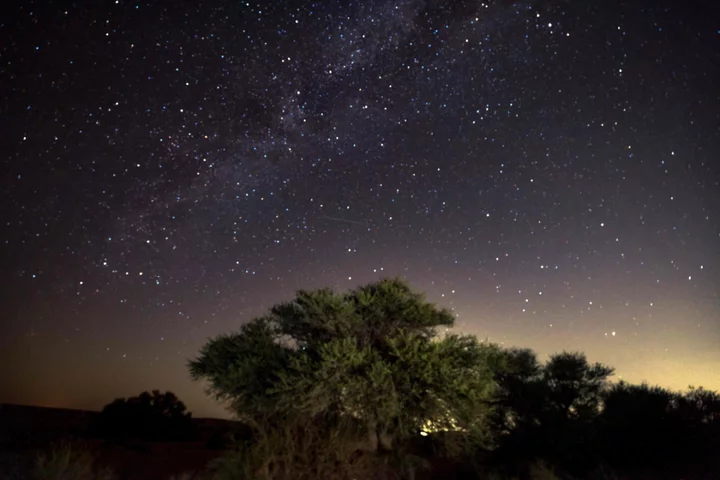
Ex-NASCAR driver Austin Theriault running to unseat Democratic Rep. Jared Golden in Maine
NASCAR driver-turned-politician Austin Theriault wants the opportunity to challenge Democratic U.S. Rep. Jared Golden in Maine
1970-01-01 08:00

Cowboys are having issues in the red zone with Ezekiel Elliott, Pats set to visit
Dak Prescott and the Dallas Cowboys are having trouble getting touchdowns after getting inside the opponent 20-yard line
1970-01-01 08:00

Nasa has gathered a large piece of a distant asteroid. What now?
Scientists have gathered a significant chunk of a distant asteroid, which has made its way to Earth after a mission taking millions of miles. But the really useful work will begin now. Nasa’s Osiris-Rex mission flew to the distant Asteroid Bennu, scooped up a piece of the object into a canister, and then flew back to Earth to drop it off. On Sunday, Nasa picked up that canister in the Utah desert and is now working to secure it. It will then send those samples to a variety of scientists around the world, with a chunk of it being sent to more than 200 people at 38 different institutions across the world. They hope that they can use them as a “time capsule” to peer into the early universe, telling us about where we came from. “This box when it is opened of material from the surface of Bennu can tell us untold secrets of the origins of the universe, the origins of our planet and the origins of life itself,” said Queen musician Brian May, who helped with the research by mapping out the asteroid to find a landing spot. “What an incredibly exciting day.” Sample return missions are particularly exciting to scientists because they offer a look at a pristine piece of a distant world that has been undisturbed by the environment on Earth. While some pieces of asteroids and other objects can fall down to Earth, they have to make their way through the atmosphere and can be damaged and changed in the process. They also mean that researchers are able to use all of the Earth’s latest technology to study the sample. Other pieces of distant worlds have of course been studied by spacecraft and landers, but they are only able to do so with the limited instruments they take to those planets. Another advantage of sample return missions over studying the objects at their home is that scientists can look back at those samples with new sensors and equipment invented long after the sample was actually taken. Many space missions continue for years – Curiosity is still examining Mars after arriving there in 2012, and the Voyager probes are still providing information almost 50 years after they were launched – but they are only able to do so with the technology that was available when they set off. The analysis done in sample return missions really begins when the spacecraft arrives at its target: then, it starts looking at the context of the sample, gathering information about the world from which it came that should prove useful to scientists later. Osiris-Rex arrived at Bennu in 2018, and spent two years mapping the asteroid before it set off back home with its delivery. All of that information in addition to the samples could help answer a variety of questions about our planet, scientists hope. “The asteroids in our solar system contain the raw building blocks from which the Earth was made, so working out their composition will tell us a lot of how our planet formed,” said Boris Gansicke from the department of physics at the University of Warwick. “There are many open questions, for instance, where did the water that we have on Earth come from? And where did the ingredients that made life possible to develop come from? “To answer those questions, ie measure the composition of an asteroid, you need to get your ‘hands’ on them (or in this case the arm of a space mission), and this is what Osiris-Rex achieved. “In a nutshell, it’s similar to sitting in front of a delicious dinner and wanting to have the list of ingredients.” Sample return missions are almost as old as space travel itself, and the first of them were the early Apollo missions, which brought back pieces of the Moon. Those continue to be useful to scientists. Since then, as human travel into space has declined, most of the work has been done by robots. In the early 1970s, the Soviet Union’s Luna missions gathered pieces of the Moon and brought them back, and in 2020 Japan’s Hayabusa2 mission brought back pieces of the asteroid Ryugu. Scientists have high hopes for future missions: perhaps the most discussed is a mission to Mars, which would bring back the first ever pieces of that planet. Engineers have suggested that for decades, and a number of plans have been formed, but none are likely to launch any time soon. Read More Nasa spots shocking number of galaxies like our own Nasa lands Bennu asteroid samples back on Earth Nasa just delivered a piece of a distant asteroid to Earth Pieces of a distant asteroid are about to fall to Earth Nasa to return largest asteroid sample ever as UK helps with research Massive solar flare strikes Nasa spacecraft sent to study Sun
1970-01-01 08:00

Keyshawn Johnson Claims Coaches From Other Schools Helped Oregon Gameplan For Colorado, Deion Sanders
Deion Sanders is getting coaches to share their secrets, apparently.
1970-01-01 08:00

Slovenia forward Benjamin Šeško tired of Erling Haaland comparisons after good start in Bundesliga
Slovenia forward Benjamin Šeško is tired of being compared to Erling Haaland
1970-01-01 08:00

European captain Luke Donald is going with statistics over history at the Ryder Cup
Luke Donald is ignoring history when it comes to starting off the Ryder Cup
1970-01-01 08:00

Nasa spots shocking number of galaxies like our own in early universe
Scientists have spotted a shocking number of galaxies like our own in the early universe. The finding will prompt us to entirely rethink our understanding of how the universe formed the structures that surround us. Looking deep into space, scientists found that the galaxies we see in the early universe are much more like our own Milky Way than was thought possible. A team of international researchers including those at The University of Manchester and University of Victoria in Canada, used the James Webb Space Telescope (JWST) to discover that galaxies like the Milky Way are 10 times more common than what was believed based on previous observations with the Hubble Space Telescope. Many of these galaxies formed some 10 billion years ago or longer, going far back into the history of the universe. The Milky Way is a typical disk galaxy, with a shape similar to a pancake or compact disc, rotating about its centre and often containing spiral arms. These galaxies might be the kind where life can develop given the nature of their formation history, experts suggest. Astronomers previously considered these types of galaxies too fragile to exist in the early universe when galaxy mergers were more common, destroying what was thought to be their delicate shapes. Christopher Conselice, professor of extragalactic astronomy at The University of Manchester, said: “Using the Hubble Space Telescope we thought that disc galaxies were almost non-existent until the universe was about six billion years old, these new JWST results push the time these Milky Way-like galaxies form to almost the beginning of the universe.” He added: “These JWST results show that disc galaxies like our own Milky Way, are the most common type of galaxy in the universe. “This implies that most stars exist and form within these galaxies which is changing our complete understanding of how galaxy formation occurs. “These results also suggest important questions about dark matter in the early universe which we know very little about.” “Based on our results, astronomers must rethink our understanding of the formation of the first galaxies and how galaxy evolution occurred over the past 10 billion years.” The researchers say their findings, published in the Astrophysical Journal, completely overturn the existing understanding of how scientists think the universe evolves, and the scientists say new ideas need to be considered. Lead author Leonardo Ferreira, from the University of Victoria, said: “For over 30 years it was thought that these disc galaxies were rare in the early universe due to the common violent encounters that galaxies undergo. “The fact that JWST finds so many is another sign of the power of this instrument and that the structures of galaxies form earlier in the universe, much earlier in fact, than anyone had anticipated.” The improved technology of JWST allows astronomers to see the true structure of these galaxies for the first time. A paper describing the findings, ‘The JWST Hubble Sequence: The Rest-Frame Optical Evolution of Galaxy Structure at 1.5 The Astrophysical Journal. Additional reporting by agencies Read More Nasa just delivered a piece of a distant asteroid to Earth Nasa lands Bennu asteroid samples back on Earth Pieces of a distant asteroid are about to fall to Earth Nasa just delivered a piece of a distant asteroid to Earth Nasa lands Bennu asteroid samples back on Earth Pieces of a distant asteroid are about to fall to Earth
1970-01-01 08:00

Tennis-Rybakina withdraws from Pan Pacific Open
Former Wimbledon champion Elena Rybakina on Monday pulled out of the Pan Pacific Open in Tokyo, days after
1970-01-01 08:00

Chelsea owners ‘need to support plan’ despite rocky run – Mauricio Pochettino
Mauricio Pochettino says Chelsea’s owners must look past their disappointment and back him to implement the plan he was hired to draw up in order to lift the club out of their slump. Defeat to Aston Villa at Stamford Bridge on Sunday means the team have taken an average of 0.85 points per game over the last 35 matches, three short of a full league season. Over a single campaign they would have won 32 points, a tally that would have seen them relegated in every Premier League season since the league became 38 games in 1995, and would have left them bottom of the table in five of them. That run goes back to October 19 last year when the team, then managed by Graham Potter, drew 0-0 away at Brentford. Pochettino is the fourth manager to have led the side in that period, with Potter having been removed on April 2 and Frank Lampard taking over until the end of the campaign, with a single game in charge for caretaker boss Bruno Saltor. Despite the turnover of coaches, the Blues have won only six times in the league in the 11 months since, drawing 12, giving them a return of 30 points from 35 games. The squad assembled by co-owner Todd Boehly’s Clearlake Capital consortium at a cost of more than £1billion over the last 16 months are currently 14th in the table after six games and have not scored in 285 minutes of play. Pochettino encouraged supporters to keep faith and focus on the quality of recent performances rather than the club’s relegation form over the last year. “It’s about learning, it’s about the process,” he said after Ollie Watkins’ second-half goal for Villa condemned his side to their third loss of the season. “We are a young team (in) a process that they need to learn all together. It’s difficult to talk about positives because when you lose it’s difficult, but we need to talk about positive things. “No doubt that with time the team is going to perform, but of course now we cannot hide the situation. It’s a situation that disappoints all the fans, the club, us and the players. “They (the owners) are disappointed, they arrive to the club and (were) so excited to build some project. Of course they feel disappointed, but at the same time they need to support the plan.” If there was a bright spot for Chelsea it was the return of striker Armando Broja after nine months out with an ACL injury. The Albania international came off the bench in the second half and headed wide in the closing minutes as the team sought an equaliser. “It was good to see Broja after nine, 10 months,” said Pochettino. “Again I think to have the possibility to have different options is good for the team. But he needs to build his confidence also.” Watkins’ goal was his first in the league this season and the striker admitted it was a weight off his shoulders. “The first one is always hard to get,” Watkins told VillaTV. “I’m delighted to get off the mark now. “It’s a bit of a relief, really, because the more the games go by, there’s a lot of talk and pressure. “But I just try and block that out and I back myself in front of goal no matter what anyone says. “I’m looking forward to the games coming up now and plenty more goals for the season.” Read More Charity boss speaks out over ‘traumatic’ encounter with royal aide Ukraine war’s heaviest fight rages in east - follow live Hooker Johnny Matthews is a perfectly able deputy for Scotland – John Dalziel Axed Jason Roy urged to remain positive with World Cup role still a possibility ECB unable to commit to equal pay targets for England men and women
1970-01-01 08:00

Americans' losing streak in Europe reaches the 30-year mark in the Ryder Cup
The United States won the Ryder Cup in England in 1993
1970-01-01 08:00

Phillies have the arms and big bats to make a second straight run at the World Series
The Philadelphia Phillies need one win to clinch their second straight playoff berth
1970-01-01 08:00

Doping-US figure skater Zhou slams anti-doping system's failures ahead of Valieva hearing
The global anti-doping system is "failing athletes", American figure skater Vincent Zhou said on Monday ahead of Russian
1970-01-01 08:00
